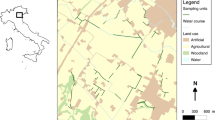Summary
Forty-four sites in the Harvard Forest were assessed with respect to overall physiognomy of the vegetation, coverabundance estimates of the woody species and several environmental variables. The data were subjected to cluster analysis and ordination. In the latter, principal component analysis produced more acceptable and clear-cut results than a Bray-Curtis ordination. The major gradient of vegetational variation is due to disturbance, followed by a moisture gradient and what appears to be a soil texture and soil depth gradient. The high proportion of variance which is not associated with common trends in the vegetation suggests that random variation is an important factor in the composition of the forest. The data obtained from the rapid estimates of physiognomy and species composition, and the methods used for analysing them, are considered to be satisfactory. The success of the approach lies in how well the number of sites used represents the study area as a whole.
Similar content being viewed by others
References
Austin, M. P. & P. Greig-Smith. 1968. The application of quantitative methods to vegetation survey. I. Some methodological problems from rain forest. J. Ecol. 56: 827–844.
Austin, M. P. & I. Noy-Meir. 1971. The problem of non-linearity in ordination: experiments with two-gradient models. J. Ecol. 59: 763–773.
Gauch, H. G. & R. H. Whittaker. 1972. Comparison of ordination techniques. Ecology 53: 568–575.
Maarel, E. van der 1969. On the use of ordination models in phytosociology. Vegetatio 19: 21–46.
Moore, J. J., S. J. P. Fitzsimons, E. Lambe & J. White. 1970. A comparison and evaluation of some phytosociological techniques. Vegetatio 20: 1–20.
Raup, H. M. 1964. Some problems in ecological theory and their relation to conservation. J. Ecol. 52 (Suppl.): 19–28.
Stout, B. B. 1952. Species distribution and soils in the Harvard Forest. Harvard Forest Bulletin No. 24.
Swan, J. M. A. 1970. An examination of some ordination problems by use of simulated vegetational data. Ecology 51: 89–102.
Whittaker, R. H. & H. G. Gauch. 1973. Evaluation of ordination techniques. p. 289–321. In: Whittaker, R. H. (ed.) Handbook of vegetation science, Part V. Ordination and classification of communities. Dr. W. Junk, Publ., The Hague.
Swan, J. M. A., R. L. Dix & C. F. Wehrhahn. 1969. An ordination technique based on the best possible stand-defined axes and its application to vegetational analysis. Ecology 50: 206–212.
Walker, B. H. & C. F. Wehrhahn. 1971. Relationships between derived vegetation gradients and measured environmental variables in Saskatchewan wetlands. Ecology 52: 85–95.
Walker, B. H. 1974. Some problems arising from the preliminary manipulation of plant ecological data for subsequent numerical analysis. J. S. Afr. Bot. 40: 1–13.
Author information
Authors and Affiliations
Additional information
Nomenclature follows ‘Gleason. H.A. and A. Cronquist. 1963. Manual of vascular plants of northeastern United States and adjacent Canada. D. Van Nostrand Co. Inc., Princeton, N.J. 810 p.’
I thank Prof. H. Raup, Dr. E. Gould and Mr. W. Lyford for discussion and comments on the results of this study, and Dr. J. M. A. Swan for criticizing the initial manuscript.
Rights and permissions
About this article
Cite this article
Walker, B.H. Vegetation — Site relationships in the Harvard forest. Plant Ecol 29, 169–178 (1975). https://doi.org/10.1007/BF02390008
Accepted:
Issue Date:
DOI: https://doi.org/10.1007/BF02390008




